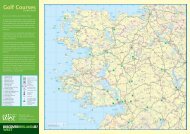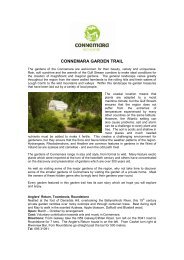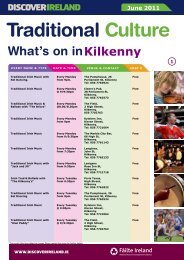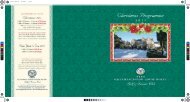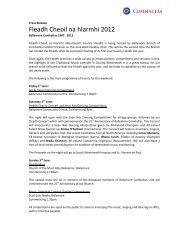Boyne Valley brochure [pdf, 8.03MB] - Discover Ireland
Boyne Valley brochure [pdf, 8.03MB] - Discover Ireland
Boyne Valley brochure [pdf, 8.03MB] - Discover Ireland
Create successful ePaper yourself
Turn your PDF publications into a flip-book with our unique Google optimized e-Paper software.
Drogheda Museum, Millmount<br />
Millmount Museum and Martello Tower<br />
are situated on high ground in the heart<br />
of Drogheda near to where the river <strong>Boyne</strong><br />
finally meets the sea<br />
Shortly after the Anglo-Norman King Henry II granted him the<br />
Kingdom of Meath in 1172, Hugh de Lacy constructed a motte<br />
and bailey on a huge mound overlooking the River <strong>Boyne</strong>. A<br />
more substantial stone fort replaced the earlier structure.<br />
According to Irish mythology, the mound<br />
was the burial place of Amergin mac Míled,<br />
druid, bard and judge of the Milesians.<br />
Amergin was the son of Míl Espáine and<br />
brother of Éremón (see Myths & Legends,<br />
p. 52). The true origin of the mound is<br />
unclear, however, it is thought that it may<br />
be a large passage tomb, similar to those<br />
at nearby Brú na Bóinne.<br />
This castle formed part of the defences<br />
of the town during Cromwell’s siege of<br />
Drogheda in 1649. The garrison was<br />
massacred when they surrendered to<br />
Parliamentarian troops on September<br />
28 FOR MORE INFORMATION GO TO WWW.BOYNEVALLEYDRIVE.IE<br />
11th, 1649. In the early 1800s the earlier<br />
fortifications were demolished and<br />
replaced by a Martello Tower as part of a<br />
series of defences erected along the Irish<br />
coast by the British in expectation of an<br />
invasion by Napoleon Bonaparte.<br />
Millmount Museum houses various<br />
exhibitions dealing with archaeology,<br />
folklife, local history, geology, industry and<br />
military history. The museum also contains<br />
one of the four surviving examples of an<br />
ancient type of fishing vessel, called a<br />
coracle, that were once a common sight<br />
on the <strong>Boyne</strong>. Coracles were made of<br />
wicker and covered with animal hide, or<br />
more recently with canvas. It was almost<br />
square but with rounded corners and was<br />
operated by two people – one paddling at<br />
the bow, the other manning the nets.<br />
Millmount Cultural Quarter offers a wide<br />
ranging experience including the museum,<br />
martello tower and an array of craft shops,<br />
artists’ studios and a café.<br />
Did you know? The fort at Millmount was<br />
considerably damaged during the Irish<br />
Civil War (1922-23) when it was occupied<br />
by Anti-Treaty forces and was shelled for<br />
several hours by the Irish Free State Army.<br />
It was restored by Drogheda Corporation<br />
and opened to the public in 2000.<br />
Contact Details:<br />
Millmount Museum,<br />
Millmount Complex,<br />
Drogheda, Co. Louth<br />
T: +353 (0)41 9833097<br />
F: +353 (0)41 9841599<br />
E: info@droghedamuseum.ie<br />
W: www.millmount.net<br />
GPS: 53.712482, -6.350055<br />
Notes:<br />
Please note last tour<br />
is 60 minutes<br />
before closing.<br />
FOR OPENING TIMES AND ADMISSION DETAILS PLEASE SEE PULL OUT INSERT AT THE BACK 29


![Boyne Valley brochure [pdf, 8.03MB] - Discover Ireland](https://img.yumpu.com/13306944/30/500x640/boyne-valley-brochure-pdf-803mb-discover-ireland.jpg)




